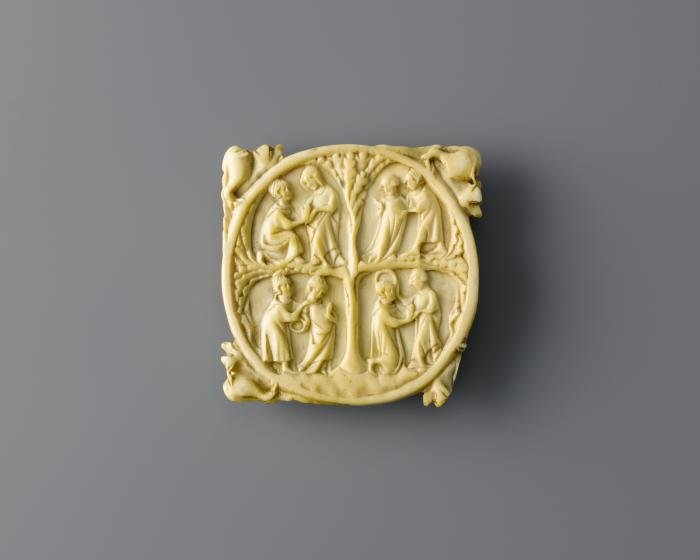Countering the Heat of Love with the Cool Touch of Ivory: A Medieval Romance
Myckynzie Schroeder - April 9, 2023
Figure 1: Mirror case, 14th century. Ivory, Kunstgewerbemuseum, Berlin.
In a world of knowing one’s “love languages” and seeking partners through mobile apps, it is increasingly easy to feel lost in the sea of modernity that has overtaken the age-old mysticism of love. While many aspects of present-day romantic relationships may not resemble the rules that governed courtly love of the European Middle Ages, the intrinsic nature of love is unchanged.
According to twelfth-century author Andreas Cappelanus’s Treatise on Love, courtly love was a thought-driven process reliant upon the interplay between love and obsession. Love was a form of inborn suffering from experiencing another’s beauty, which spurs an uncontrollable desire for intimacy and embrace. This uncontrollability is what compels the human mind to attempt to understand love, and has made aspects of the way humans engage in love constant throughout time. Modern love is often expressed through the giving of gifts to the person that is the object of one’s affection, and unsurprisingly this nearly universal form of expression is not unique to the modern era.
For those entwined in the medieval era’s struggle of courtly love, gifts served to further a lover’s affections. In the initial stages of partnership, these gifts were small, to save expenses for more extravagant gifts later. However, by the time one had come to the point of knowing true love, gifts adorned with precious materials and ornate details were warranted to maintain such love.
These medieval gifts can be exemplified by a compact mirror made of ivory, whose carvings tell the story of two lovers as they journey through their relationship (Figure 1). Such a gift is highly embedded in the framework of emotion, as it both physically and symbolically embodies the connection between two people and their love for one another. This choice of gift to narrate their story serves to further establish the object’s emotional value in addition to the carvings of the case which evoke these feelings of love and affection in a more obvious manner.
The front case of the mirror is divided into four quadrants by a large central tree, whose branches then encircle each moment as if it were sprouted through symbiosis with their love, growing with the lovers’ bond. The tree’s encompassing branch formation serves as protection from the world’s monsters, like avarice and sin, which lie on each of the four corners of the compact. Within the tree’s bounds, however, the lovers remain undisturbed and blissfully unaware of the monsters that lurk beyond.
The first of these quadrants depicts their meeting and initial encounter: a young man kneels before a lady with their hands intertwined. Moving to the next panel, their relationship has progressed, and the two now stand in flirtatious conversation, the man leaning towards the lady while she flicks her opposite wrist. This interaction shows not only their progression through time but also in proximity, as the two are now on an equal plane and embraced further. In the third section, their interaction progresses to erotic displays of affection, as the young man chucks the woman under her chin with a chaplet in his other hand. Moving to the right, the final panel shows his lover placing this chaplet upon his head while he kneels before her, again holding hands in an intimate embrace that parallels the first moment to bring the love story full circle.
From the content and perspective of a lover, the intention of this token is clear. The giver of this gift wishes to display their love and affection for the receiver through a physical embodiment of their love and history together. Furthermore, the desire to do so also elicits a resonance of deep connection and joy, showcasing the pure bliss that is true love under the principles of courtly love. The chronological story-telling of their romance then serves to further the assertion of their relationship as an embodiment of the courtly love ideology, showcasing how the two journeyed from strangers to a pair madly in love.
In the most physical sense, this gift conveys these intentions through the choice of material. Ivory was one of the most sought-after carving materials, and was elusive and expensive due to the necessity for overseas import of the material. This alone made it a vehicle for the portrayal of courtly love, as pieces with a high monetary value were used as a means of displaying romantic devotion. Additionally, the smooth, soft texture of ivory rendered it the perfect symbol for the beauty, purity, and virtue of a lover’s skin, allowing it to serve as an extension of their body. Another source for its perceived purity is found in its being cool to the touch and non-heat conducting, rendering it immune to corruption through the heat of passion, sin, or avarice. This embodiment of fundamental virtues and invulnerability to worldly vices elevated ivory to its status as a desired canvas on which to sculpt love tokens. Thus, the ivory itself serves as a material embodiment of perfect courtly love in its purest form. Its intended use also serves as a vehicle to deliver these feelings to the lover then through its incorporation into the lover’s everyday life. Even when the two are apart, the gift serves to remind her of his presence and their love.
The function of a mirror also inherently ties back to the ideals of courtly love through its facilitation of beauty. By giving his lover a mirror, he encourages her to foster her beauty—by extension growing their love due to its relationship to beauty in courtly love. The content continues the symbolism of having attained perfect courtly love through the incorporation of nature. The depiction of their love enshrined and supported by a large central tree emphasizes the naturalism of love. Without the approval of nature, their love could not have flourished, ingraining the relationship with a form of sanctity by evoking the endorsement of mother nature herself. The progression of the tale in a circular manner also focuses attention on the constant presence of mutual admiration and consent. Although her love may not have been immediately attainable, that would have been undesirable as courtly love dictates the need for one to earn a lover’s affection. In this way her need to be wooed encourages his love, fostering their bond. These added layers of symbolic meaning further the emotional impact of the piece by infusing it with the hallmarks of an idealized love connection.
While modern views on gender dynamics, the “rules” of love, and ethical views on ivory have changed, many of the emotional motivations and intricacies of love have remained constant. The presence of a ‘natural’ or fated bond between two lovers has been a longstanding lens through which this mystical force is viewed, making its implicit control over courtly love an almost deified opinion on relationships in the medieval era. Through the designing and giving of gifts that portray a symbiosis of one’s love with nature, one ordains their relationship with the highest form of approval while simultaneously validating this opinion with meaningful emotional impact through symbolism in both content and physical material.
Image Credit: Gothic Ivories Project at The Courtauld Institute of Art, London, www.gothicivories.courtauld.ac.uk, accessed Apr. 9, 2023.
Reference: Andreas Capellanus, The Art of Courtly Love, trans. Parry. Columbia UP, 1941, pp. 28-36, 177-186.

